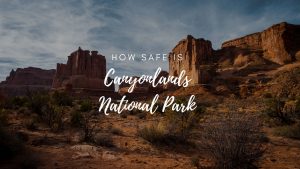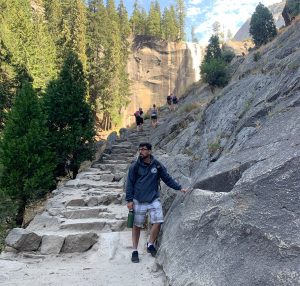Do You Need Trekking Poles For Yosemite National Park?

If you’re thinking of hiking in Yosemite National Park, you may be wondering if trekking poles are necessary. After all, if you’ve gone hiking before, I’m sure you’ve seen many people hike without them and seem to do just fine.
That said, there are some good reasons to consider using trekking poles in Yosemite, especially if you’re hiking on some of the more challenging trails. We’ll get into the benefits, some trails where they are a must, and then you can decide for yourself if they’re something you want to use on your next hike in Yosemite National Park.
Quick Links
Benefits Of Using Trekking Poles In Yosemite Valley
There are several benefits of using trekking poles, especially when hiking in Yosemite National Park. Here are a few of the most notable benefits:
They Improve Balance and Stability
Trekking poles can help improve your balance and stability, especially on uneven or slippery terrain. This can be extremely helpful when hiking in Yosemite, where the trails can get quite rocky and steep, very fast.
They Take Some of the Strain Off Your Legs
Trekking poles can also take some of the strain off your legs, particularly your knees. This is especially helpful on long hikes or when hiking downhill.
They Help You Go Faster
Believe it or not, trekking poles can also help you go faster. That’s because they provide an extra point of contact with the ground, which gives you more leverage and power to push off with each step. This isn’t super important – unless you plan on doing an overnight and need to make time to hit the trailhead before dark.
They Help You Save Energy
Another nice benefit of using trekking poles is that they can help you save energy. This is because they take some of the strain off your legs and allow you to use your arms more when hiking. This can be extremely helpful on long or steep hikes.
They Help You Stay Safe
Trekking poles can also help you stay safe on the trail. That’s because they provide an extra point of contact with the ground, which can help you avoid falls or other accidents. They can also be used to probe for potential hazards on the trail, like holes or roots, or even poison ivy.
Recommendation: If you’re looking for some information on how to choose your next trekking pole, check out our guide on the best budget trekking poles.
Which Trails Do I Need Trekking Poles For Yosemite?
While you don’t need trekking poles for every trail in Yosemite National Park, there are some trails where they can be quite helpful. While Yosemite is generally a safe park, there are a few trails that are quite difficult. Here are a few of the most popular trails where you might want to consider using trekking poles:
The John Muir Trail
The John Muir Trail is one of the most popular trails in Yosemite National Park. It’s also one of the most challenging, with an elevation gain of over 40,000 feet. The total length of the trail is over 200 miles, but most people use the John Muir trail as an exit for a few of the popular trails. Trekking poles can be helpful on the John Muir, especially as you’re descending because it’s going to be nothing but steep switchbacks until you’re on the way down. Trekking poles will help give you peace of mind on the trail and help you maintain your balance.
The last time I did the John Muir trail, I didn’t have trekking poles with me. And personally, I had more ankle and knee issues going down the John Muir trail than any other trail on Yosemite – take that as you will.
Upper Yosemite Falls Trail
The Yosemite Falls Trail is another popular trail in Yosemite National Park. Keep in mind that there are two Yosemite Falls Trails, the Upper and Lower. The Lower trail is much shorter and has very little elevation gain – you won’t need trekking poles if you’re doing the shorter trail.
However, the Upper Yosemite Falls trail has an elevation gain of 3,218 feet and a total length of nearly 8 miles. It’s considered a very strenuous hike and can be quite challenging. Trekking poles can be helpful on this trail, especially if you’re not used to hiking at high altitudes.
The Mist Trail
The Mist Trail is one of the most popular trails in Yosemite National Park. It’s also one of the more challenging, with an elevation gain of over 2,000 feet and a granite staircase with over 600 narrow and sometimes, wet steps. Trekking poles can be helpful on this trail, especially if the waterfalls are flowing and you want to avoid getting wet.
Vernal And Nevada Falls via Mist Trail
Right after the Mist Trail, you’ll find the Vernal and Nevada Falls. If you have ever done the Mist Trail without trekking poles, you know those granite stairs are no joke. And you need to cross that staircase to get to Vernal Falls. After Vernal, it’s another couple hundred to get to Nevada Falls. If you don’t want your legs to feel like jello by the time you make it to the top, I recommend using trekking poles.
The Half Dome Trail
The Half Dome Trail is one of the most popular and challenging trails in Yosemite National Park. It’s 15 miles long with an elevation gain of over 5,000 feet. Trekking poles can be helpful on this trail, especially if you have any joint pain or other issues that make hiking difficult.
When Should You Not Use Trekking Poles in Yosemite?
There are also many trails where you might not want to use trekking poles. Instead of listing out all the trails, I’ll give you a few general guidelines of when you can probably leave them at home:
- If the trail is short and has little to no elevation gain, you most likely won’t need trekking poles.
- Trekking Poles weigh you down and can be a bit of a pain to carry, so if you’re not going to be using them a majority of the time, leave them at home.
- If you’re used to hiking without trekking poles and feel comfortable doing so, there’s no need to use them just because other people are.
- If the terrain is generally smooth and paved, you won’t necessarily need trekking poles.
In general, you should use your best judgment when deciding whether or not to use trekking poles on any given trail. And don’t be afraid to ask the ranger at the visitor center which trails they recommend using trekking poles on.
Conclusion
Trekking poles can be a helpful tool for hikers of all levels, but they’re not necessary for everyone – or even every trail. Use your best judgment to decide whether or not trekking poles are right for you on any given trail. And when in doubt, ask a ranger!
Do you have any other tips for using trekking poles in Yosemite? Did I miss any important trails that could use some trekking poles? Let me know in the comments






